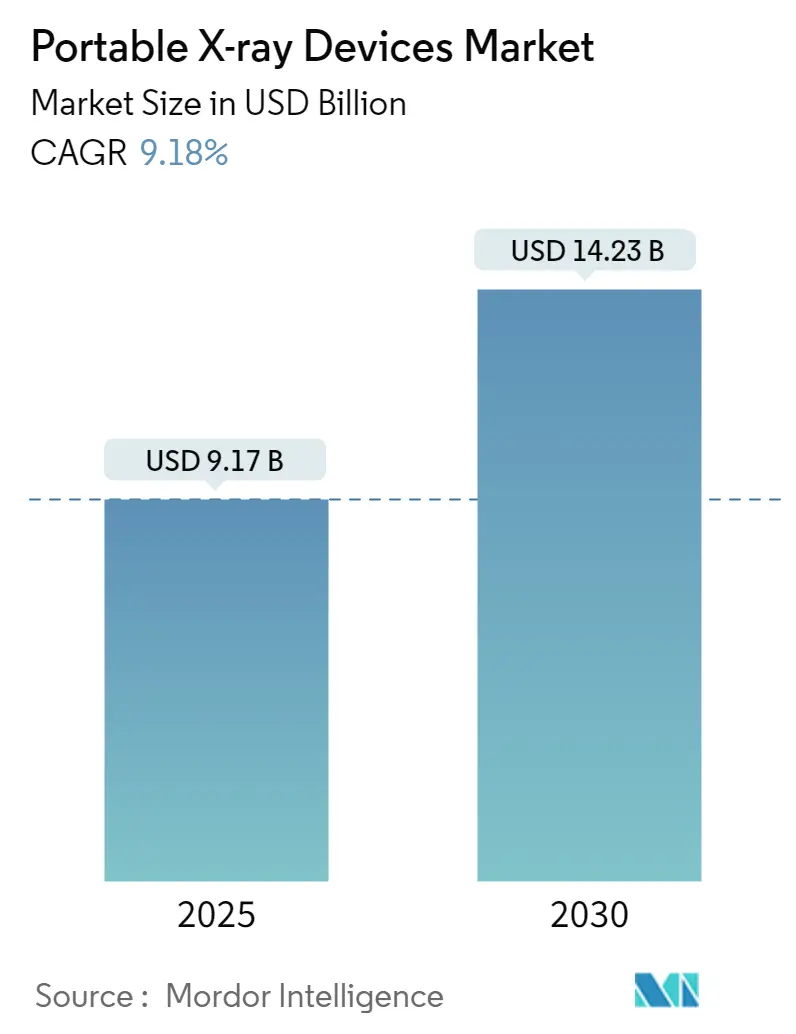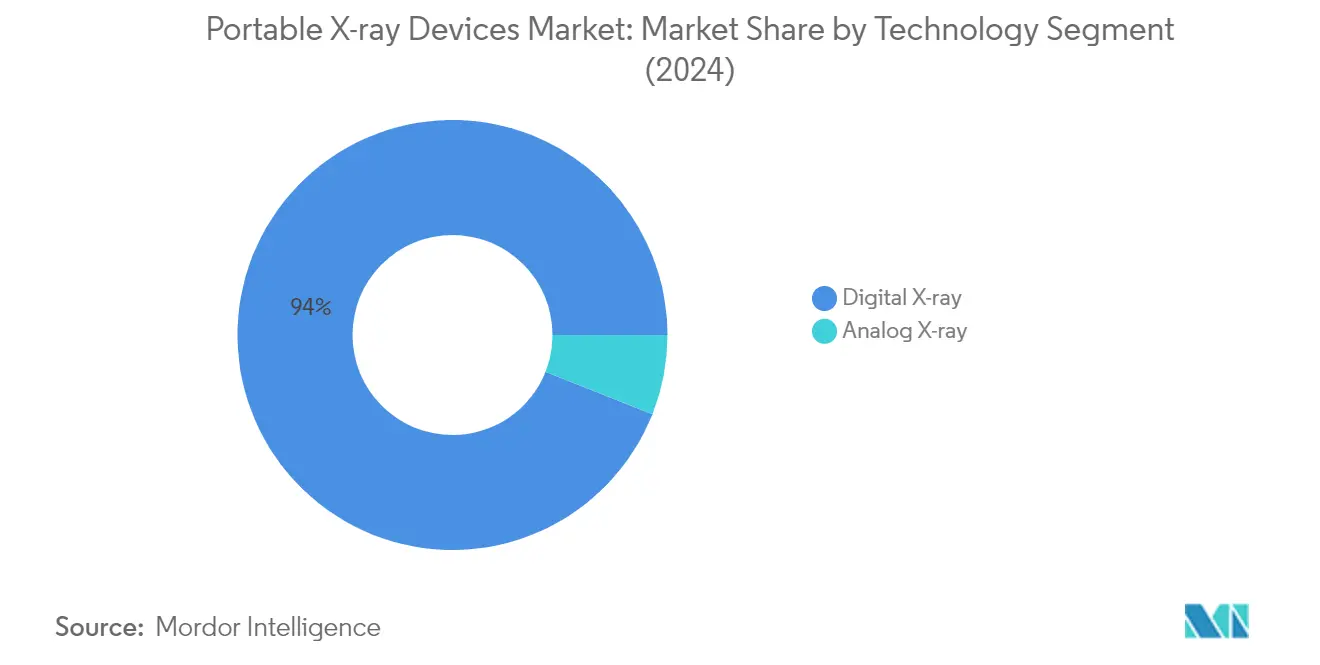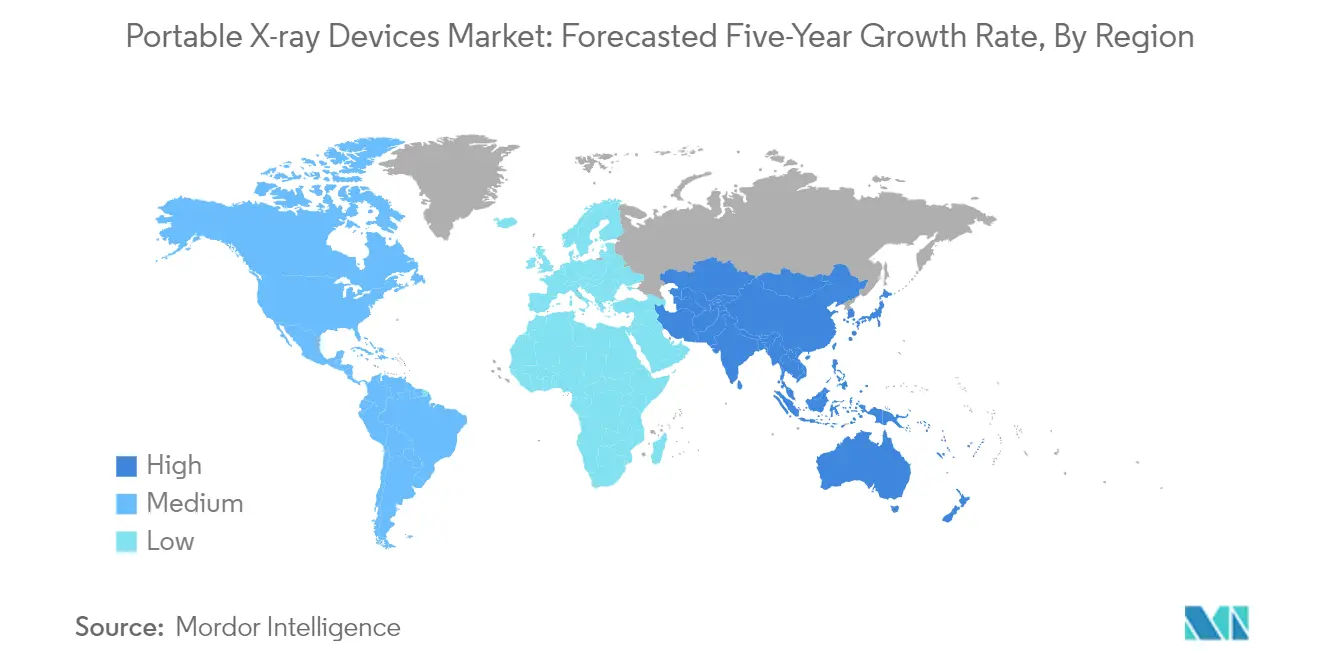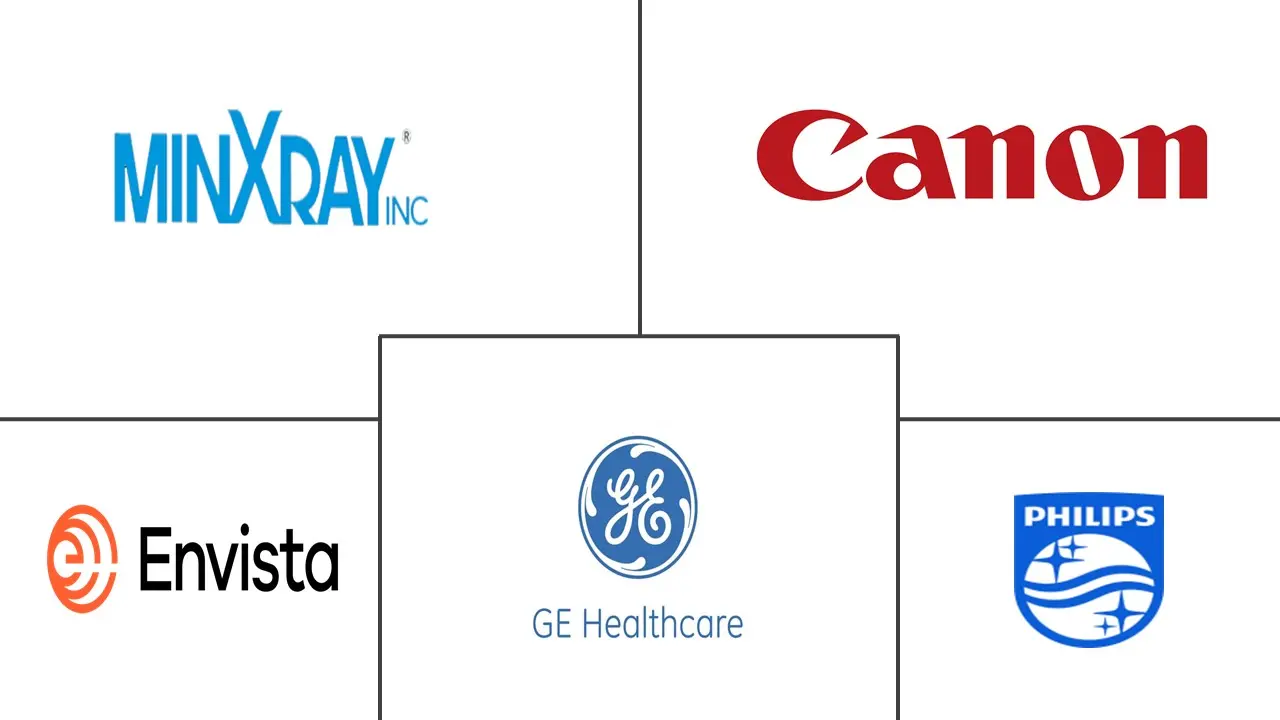
Portable X-ray Devices Market Analysis
The Portable X-ray Devices Market size is estimated at USD 9.17 billion in 2025, and is expected to reach USD 14.23 billion by 2030, at a CAGR of 9.18% during the forecast period (2025-2030).
The portable X-ray devices industry is experiencing a significant transformation driven by the increasing demand for point-of-care diagnostics and the shift towards more flexible healthcare delivery models. Healthcare facilities are increasingly adopting mobile X-ray equipment and portable radiography equipment solutions to improve patient care accessibility and reduce the need for patient transport. This evolution is particularly evident in emergency care settings, intensive care units, and home healthcare services, where immediate diagnostic capabilities are crucial for timely medical interventions. The integration of these devices into various healthcare settings has led to improved workflow efficiency and better patient outcomes through faster diagnosis and treatment initiation.
The market is witnessing a notable shift towards digital transformation and smart healthcare solutions, with artificial intelligence and machine learning becoming integral components of portable X-ray systems. In June 2023, the United Kingdom's Department of Health and Social Care implemented a significant initiative by investing in AI-powered diagnostic technologies, launching multiple pioneering projects aimed at revolutionizing patient care and accelerating diagnosis processes. These technological integrations are enhancing image quality, reducing radiation exposure, and enabling more accurate diagnostic capabilities, ultimately improving the overall efficiency of healthcare delivery systems.
The industry landscape is being reshaped by strategic collaborations between healthcare providers and technology companies, focusing on developing more sophisticated and user-friendly portable X-ray solutions. Major market players are increasingly focusing on product innovations and launches to address specific healthcare needs. For instance, in September 2023, GE Healthcare introduced the AMX Navigate, a revolutionary digital portable X-ray system featuring a power-assisted free motion telescoping column, which significantly reduces operator strain and improves workflow efficiency. This development represents a broader trend of manufacturers focusing on ergonomic design and user comfort while maintaining high diagnostic accuracy.
The market is also experiencing a shift in healthcare delivery models, with an increasing emphasis on preventive care and early diagnosis. Healthcare providers are adopting portable X-ray equipment as part of their preventive healthcare strategies, enabling more frequent and convenient screening programs. This trend is particularly evident in rural and underserved areas, where portable X-ray devices are becoming essential tools for improving healthcare accessibility. The integration of these devices with hospital information systems and electronic health records is further streamlining healthcare delivery and improving patient care coordination across different healthcare settings.
Portable X-ray Devices Market Trends
Technological Advancements
The integration of artificial intelligence and advanced imaging technologies has revolutionized the portable X-ray devices market, significantly improving diagnostic accuracy and workflow efficiency. According to research published in the Journal of the American Medical Association, AI-enabled algorithms have demonstrated superior detection capabilities for pulmonary nodules on chest radiographs compared to traditional interpretation methods. The implementation of smart worklist prioritization through AI has substantially reduced report turnaround times (RTAT) for critical findings in chest X-rays, as evidenced by studies in the Imaging Informatics and Artificial Intelligence Journal.
Recent technological developments have focused on enhancing both hardware and software capabilities of portable X-ray machines. For instance, the incorporation of solution-processed materials has advanced next-generation X-ray imaging technologies, offering benefits such as low-cost implementation, high sensitivity, and improved flexibility. Major manufacturers have introduced innovative features such as power-assisted Free Motion telescoping columns, which reduce lift force by up to 70% and decrease technologist injury risk. Additionally, the integration of Zero Click Exam capabilities and automated workflow processes has significantly improved operational efficiency and reduced user interface interactions, making these devices more user-friendly and productive in clinical settings.
Growing Geriatric Population and Increasing Prevalence of Vascular Diseases
The global demographic shift towards an aging population has created an unprecedented demand for portable X-ray machines, with the United Nations Department of Economic and Social Affairs projecting the number of persons aged 65 years or over to reach nearly 1.5 billion by 2050, more than double from the current 727 million. This demographic trend is particularly significant as the elderly population is more susceptible to various medical conditions requiring regular diagnostic imaging. The British Heart Foundation's Global Heart & Circulatory Diseases Factsheet reveals that approximately 200 million people globally are affected by coronary heart disease, while peripheral arterial disease affects around 110 million individuals.
The increasing prevalence of age-related conditions has created a substantial need for mobile radiography systems. Studies indicate that about two in three adults aged 65 years or older experience gum disease, and nearly all adults (96%) in this age group have experienced cavity formation, with one in five facing untreated tooth decay. Furthermore, the burden of breast cancer in the elderly population is expected to rise significantly, with estimates showing that the number of new breast cancer cases in individuals aged 60 years or above is projected to increase from 1,027,785 in 2020 to 1,583,022 by 2040, highlighting the critical need for accessible diagnostic imaging solutions.
Huge Funding for R&D of Portable Technologies by Private Players and Government
Substantial financial support from both government agencies and private sector entities has significantly accelerated the development and adoption of mobile X-ray machines. Notable government initiatives include the Morrison Government's investment of USD 6.6 million in research projects, with a specific allocation of USD 1.97 million to the University of Adelaide for mobile X-ray services in residential aged care facilities. The UK Government's Department of Health and Social Care has demonstrated similar commitment by providing GBP 36 million to boost artificial intelligence technologies in healthcare, supporting approximately 38 pioneering AI projects aimed at revolutionizing care and accelerating diagnosis.
Private sector investments and strategic collaborations have further enhanced the development of the advanced portable X-ray devices market. Major manufacturers have established dedicated research facilities and innovation centers to drive technological advancement in this field. For instance, Shimadzu Corporation has expanded its research capabilities through the establishment of Shimadzu Research Laboratory (Europe) Ltd, focusing on developing basic technologies for X-ray imaging. Additionally, the Indian Ministry of Chemical and Fertilizers has implemented the Production Linked Incentive (PLI) Scheme, providing substantial funding support of INR 50 crores to companies like Allengers Medical Systems Limited for manufacturing various imaging technologies, including X-ray systems, demonstrating the government's commitment to advancing medical imaging capabilities.
Segment Analysis: By Technology
Digital X-ray Segment in Portable X-ray Devices Market
The digital X-ray segment dominates the portable X-ray devices market, commanding approximately 94% of the total market share in 2024. This segment's leadership position is attributed to several key advantages over conventional analog systems, including enhanced image quality, lower radiation exposure, and superior diagnostic capabilities. Digital X-ray systems have revolutionized medical imaging by enabling immediate image visualization, digital enhancement capabilities, and seamless integration with hospital information systems. The segment's growth is further propelled by technological advancements such as artificial intelligence integration for improved diagnostic accuracy, noise reduction circuits for better image granularity, and cloud-based image sharing capabilities. Healthcare facilities worldwide are increasingly adopting digital X-ray systems due to their ability to streamline workflow, reduce waiting times, and provide long-term cost benefits despite higher initial investment.

Analog X-ray Segment in Portable X-ray Devices Market
The analog X-ray segment continues to maintain a presence in the portable X-ray devices market, particularly in regions with budget constraints or in facilities requiring basic radiographic capabilities. These traditional systems, while gradually being phased out in developed markets, still serve as cost-effective solutions for certain healthcare settings. Analog X-ray systems utilize photographic plates for image storage and operate through conventional radiographic principles. Despite their limitations in terms of image quality and radiation exposure, these systems remain relevant in specific applications where digital infrastructure is not readily available or where initial cost considerations are paramount. The segment's sustainability is supported by its reliability, simpler maintenance requirements, and lower upfront costs compared to digital alternatives.
Segment Analysis: By Application
Dental X-ray Segment in Portable X-ray Devices Market
The dental X-ray segment maintains its dominant position in the dental X-ray machines market, accounting for approximately 35% of the total market share in 2024. This leadership position is primarily driven by the growing use of portable dental X-ray devices for various dental applications, including the identification of tooth decay beneath existing fillings, visualization of decay areas in teeth, and assistance in tooth implants, braces, and dentures. The segment's strong performance is further supported by technological advancements in dental imaging, the increasing prevalence of dental diseases globally, and the rising demand for early-stage diagnosis in dental care. Additionally, the convenience and accuracy offered by portable dental X-ray systems compared to fixed systems have significantly contributed to their widespread adoption across dental practices worldwide.
Chest X-ray Segment in Portable X-ray Devices Market
The chest X-ray segment is emerging as the fastest-growing segment in the portable X-ray devices market, projected to expand at approximately 10% during the forecast period 2024-2029. This remarkable growth is attributed to the increasing prevalence of respiratory diseases, cardiovascular conditions, and the growing need for point-of-care diagnostics. The segment's growth is further accelerated by technological innovations in chest imaging, including the integration of artificial intelligence for improved diagnostic accuracy. The rising adoption of mobile chest X-ray units in emergency departments, intensive care units, and other hospital settings, coupled with their crucial role in diagnosing various chest conditions, including pneumonia, emphysema, and lung cancer, continues to drive the segment's expansion.
Remaining Segments in Application Segmentation
The mammography and abdomen X-ray segments also play crucial roles in the portable X-ray devices market. The mammography segment is particularly significant in breast cancer screening and diagnosis, benefiting from increasing awareness about early detection and regular screening programs. The abdomen X-ray segment serves various diagnostic purposes, including the detection of digestive tract issues, kidney stones, and other abdominal conditions. Both segments continue to evolve with technological advancements, improved image quality, and enhanced portability features, making them essential components of modern healthcare diagnostics.
Segment Analysis: By Modality
Mobile X-ray Devices Segment in Portable X-ray Devices Market
Mobile X-ray devices continue to dominate the mobile digital X-ray system market, holding approximately 72% of the market share in 2024. These devices are equipped with wheels that enable easy relocation from one location to another, making them ideal for various healthcare settings, including in-patient departments, newborn intensive care units (NICU), operating rooms, and emergency departments. The segment's dominance can be attributed to their versatility in point-of-care diagnostics, offering fast and reliable imaging solutions. Mobile X-ray units are particularly valuable in rural or remote regions where fixed radiology facilities are not available, and their deployment in mobile imaging systems has significantly improved healthcare accessibility. The compact design of these devices allows for easy navigation within limited spaces like hospital wards, while their advanced features promote efficiency and patient safety without compromising image quality. The integration of artificial intelligence and enhanced cybersecurity features in modern mobile X-ray systems has further strengthened their position as the preferred choice for healthcare facilities.
Handheld X-ray Devices Segment in Portable X-ray Devices Market
The handheld X-ray devices segment is experiencing rapid growth in the portable X-ray devices market, with an expected growth rate of approximately 10% during 2024-2029. These devices are gaining significant traction due to their unique advantages of being small, lightweight, and operable with a single hand. Available in both pistol design and camera-like configurations, handheld X-ray devices offer greater operating flexibility compared to other types of X-ray equipment. Their compact size and cost-effectiveness make them particularly attractive for smaller healthcare facilities and mobile medical services. The segment's growth is being driven by continuous innovation in product design, with manufacturers focusing on developing ultra-low dose devices and incorporating advanced technologies like carbon nanotube technology. The increasing adoption of these devices in intraoral radiography, owing to their ability to produce high-resolution images of the oral cavity, has further accelerated segment growth. Additionally, the integration of intuitive interfaces and battery-operated designs has enhanced their appeal among healthcare practitioners.
Portable X-ray Devices Market Geography Segment Analysis
Portable X-ray Devices Market in North America
The North American portable x-ray devices market demonstrates robust growth driven by advanced healthcare infrastructure, increasing chronic diseases, and substantial investments in medical technology. The United States, Canada, and Mexico form the key markets in this region, with each country contributing uniquely to the market's development. The region benefits from early adoption of innovative medical technologies, a strong presence of major market players, and favorable healthcare policies that promote the use of portable x-ray systems.

Portable X-ray Devices Market in the United States
The United States leads the North American market with approximately 45% market share in 2024. The country's dominance is attributed to its extensive healthcare network, high healthcare expenditure, and increasing prevalence of chronic diseases requiring regular diagnostic imaging. The presence of major manufacturers, continuous technological advancements in portable x-ray systems, and growing demand for point-of-care diagnostics further strengthen the market position. The country's robust research and development infrastructure, coupled with significant investments in healthcare innovation, continues to drive market growth.
Portable X-ray Devices Market in Canada
Canada emerges as the fastest-growing market in North America, with an expected CAGR of nearly 9% during 2024-2029. The growth is driven by increasing healthcare accessibility initiatives, rising adoption of mobile x-ray equipment, and a growing emphasis on remote healthcare services. The country's focus on modernizing healthcare infrastructure, particularly in rural and remote areas, creates substantial opportunities for portable x-ray device manufacturers. The Canadian market also benefits from government support for healthcare technology adoption and increasing awareness about early disease diagnosis.
Portable X-ray Devices Market in Europe
The European portable x-ray devices market showcases significant growth potential, supported by advanced healthcare systems and an increasing elderly population across the region. Key markets include Germany, the United Kingdom, France, Italy, and Spain, each contributing substantially to the regional market dynamics. The region's strong focus on healthcare innovation, coupled with increasing investments in medical technology, drives market growth.
Portable X-ray Devices Market in Germany
Germany dominates the European market with approximately 21% market share in 2024, while also maintaining the fastest growth rate with a projected CAGR of nearly 10% during 2024-2029. The country's leadership position is attributed to its advanced healthcare infrastructure, substantial healthcare spending, and strong presence of major medical device manufacturers. The German market benefits from continuous technological innovations, increasing adoption of digital healthcare solutions, and growing demand for portable radiography equipment.
Portable X-ray Devices Market in Asia-Pacific
The Asia-Pacific portable x-ray devices market demonstrates dynamic growth potential, driven by improving healthcare infrastructure, increasing healthcare expenditure, and growing awareness about early disease diagnosis. The region encompasses diverse markets including China, Japan, India, Australia, and South Korea, each contributing uniquely to the market landscape.
Portable X-ray Devices Market in China
China maintains its position as the largest market in the Asia-Pacific region, driven by its extensive healthcare system modernization initiatives, large patient population, and increasing healthcare accessibility. The country's focus on technological advancement in medical imaging, coupled with growing investments in healthcare infrastructure, particularly in rural areas, continues to drive market growth.
Portable X-ray Devices Market in Japan
Japan emerges as the fastest-growing market in the Asia-Pacific region, supported by its advanced healthcare system, rapid technological adoption, and aging population. The country's strong focus on healthcare innovation, particularly in mobile x-ray systems, creates substantial opportunities for market growth. Japan's emphasis on providing efficient healthcare services to its elderly population further drives the demand for portable x-ray devices.
Portable X-ray Devices Market in Middle East & Africa
The Middle East & Africa portable x-ray devices market shows steady growth potential, driven by improving healthcare infrastructure and increasing healthcare investments. The region, comprising GCC countries and South Africa, demonstrates varying levels of market development. The GCC emerges as the largest market due to substantial healthcare investments and modern healthcare facilities, while South Africa leads in growth rate, supported by increasing healthcare accessibility initiatives and growing awareness about early disease diagnosis.
Portable X-ray Devices Market in South America
The South American portable x-ray devices market exhibits steady growth, characterized by improving healthcare infrastructure and increasing focus on medical technology adoption. Brazil emerges as the largest market in the region, benefiting from its extensive healthcare network and growing investments in medical technology. Argentina demonstrates the fastest growth rate, driven by healthcare modernization initiatives and increasing demand for mobile x-ray equipment. The region's focus on improving healthcare accessibility and growing awareness about early disease diagnosis continues to drive market development.
Portable X-ray Devices Industry Overview
Top Companies in Portable X-ray Devices Market
The portable X-ray companies market is characterized by the strong presence of established multinational corporations that are continuously driving innovation through significant research and development investments. These companies focus on developing advanced digital imaging solutions with artificial intelligence integration, improved image quality, and reduced radiation exposure. Market leaders are expanding their geographical footprint through strategic partnerships and distribution networks, particularly in emerging markets. Companies are demonstrating operational agility by rapidly adapting to healthcare needs, as evidenced during the COVID-19 pandemic with increased production of mobile X-ray machine supplier units. Strategic moves in the industry include portfolio diversification through new product launches, especially in digital radiography systems, and emphasis on after-sales service excellence. The competitive landscape also shows a clear trend towards developing user-friendly interfaces and workflow optimization solutions to enhance healthcare provider efficiency.
Consolidated Market Led By Global Players
The portable X-ray devices market exhibits a highly consolidated structure dominated by large multinational healthcare technology conglomerates with diverse medical imaging portfolios. These established players, including Siemens Healthineers, GE Healthcare, Philips, and Fujifilm, leverage their extensive research capabilities, global distribution networks, and strong brand recognition to maintain their market positions. The market shows limited presence of regional specialists, who typically focus on specific geographic regions or niche applications within the portable X-ray company segment.
The industry has witnessed significant merger and acquisition activities, particularly focused on acquiring digital imaging technologies and expanding geographical presence. Large companies are actively pursuing strategic acquisitions of smaller innovative firms to enhance their technological capabilities and maintain competitive advantage. The market's high entry barriers, including substantial capital requirements, regulatory compliance needs, and the necessity for established distribution networks, have contributed to maintaining the consolidated nature of the industry, making it challenging for new entrants to gain significant market share.
Innovation and Service Drive Market Success
Success in the portable X-ray devices market increasingly depends on companies' ability to deliver comprehensive solutions that combine advanced imaging technology with enhanced workflow efficiency and data integration capabilities. Incumbent players are focusing on strengthening their market position through continuous innovation in digital technologies, development of AI-enabled features, and expansion of their service offerings. The emphasis on building long-term relationships with healthcare providers through superior after-sales support and training programs has become crucial for maintaining market share.
For contenders aiming to gain ground, the key lies in identifying and serving underserved market segments and developing specialized solutions for specific clinical applications. The relatively low risk of substitution from alternative imaging technologies provides stability, but increasing end-user concentration in the form of large hospital chains and healthcare networks is shifting bargaining power. Regulatory requirements, particularly regarding radiation safety and image quality standards, continue to shape market dynamics and influence product development strategies. Success in this market requires a balanced approach between innovation, compliance, and customer service excellence, while maintaining cost competitiveness through operational efficiency. Leading portable X-ray machine manufacturers are capitalizing on these trends to ensure sustained growth and market leadership.
Portable X-ray Devices Market Leaders
-
GE Healthcare
-
Canon Medical Systems
-
MinXray
-
Envista Holdings Corporation (KaVo Dental GmbH)
-
Koninklijke Philips NV
- *Disclaimer: Major Players sorted in no particular order

Portable X-ray Devices Market News
- July 2022: Fujifilm Europe launched a new hybrid C-arm and portable x-ray device. The device, called FDR Cross, is designed to offer high-quality fluoroscopic and static x-ray images during surgery and other medical procedures.
- March 2022: Konica Minolta Inc. (Konica Minolta) launched AeroDR TX m01 in Japan. It is a portable X-ray system featuring a wireless dynamic digital radiography function.
Portable X-ray Devices Market Report - Table of Contents
1. INTRODUCTION
- 1.1 Study Assumptions and Market Definition
- 1.2 Scope of the Study
2. RESEARCH METHODOLOGY
3. EXECUTIVE SUMMARY
4. MARKET DYNAMICS
-
4.1 Market Drivers
- 4.1.1 Technological Advancements
- 4.1.2 Growing Geriatric Population and Increasing Prevalence of Vascular Diseases
- 4.1.3 Huge Funding for R&D of Portable Technologies by Private Players and Governments
-
4.2 Market Restraints
- 4.2.1 Stringent Regulatory Scenario
- 4.2.2 High Risk of Radiation Exposure
-
4.3 Porter Five Forces
- 4.3.1 Threat of New Entrants
- 4.3.2 Bargaining Power of Buyers/Consumers
- 4.3.3 Bargaining Power of Suppliers
- 4.3.4 Threat of Substitute Products
- 4.3.5 Intensity of Competitive Rivalry
5. MARKET SEGMENTATION (Market size in USD Million)
-
5.1 By Technology
- 5.1.1 Analog X-ray
- 5.1.2 Digital X-ray
-
5.2 By Application
- 5.2.1 Dental X-ray
- 5.2.2 Mammography
- 5.2.3 Chest X-ray
- 5.2.4 Abdomen X-ray
-
5.3 By Modality
- 5.3.1 Handheld X-ray Devices
- 5.3.2 Mobile X-ray Devices
-
5.4 Geography
- 5.4.1 North America
- 5.4.1.1 United States
- 5.4.1.2 Canada
- 5.4.1.3 Mexico
- 5.4.2 Europe
- 5.4.2.1 Germany
- 5.4.2.2 United Kingdom
- 5.4.2.3 France
- 5.4.2.4 Italy
- 5.4.2.5 Spain
- 5.4.2.6 Rest of Europe
- 5.4.3 Asia Pacific
- 5.4.3.1 China
- 5.4.3.2 Japan
- 5.4.3.3 India
- 5.4.3.4 Australia
- 5.4.3.5 South Korea
- 5.4.3.6 Rest of Asia-Pacific
- 5.4.4 Middle East and Africa
- 5.4.4.1 GCC
- 5.4.4.2 South Africa
- 5.4.4.3 Rest of Middle-East and Africa
- 5.4.5 South America
- 5.4.5.1 Brazil
- 5.4.5.2 Argentina
- 5.4.5.3 Rest of South America
6. COMPETITIVE LANDSCAPE
-
6.1 Company Profiles
- 6.1.1 Envista Holdings Corporation (KaVo Dental GmbH)
- 6.1.2 Canon Medical System
- 6.1.3 GE Healthcare
- 6.1.4 Koninklijke Philips NV
- 6.1.5 MinXray
- 6.1.6 FUJIFILM Holdings Corporation
- 6.1.7 Shimadzu Corporations
- 6.1.8 Siemens Healthineers AG
- 6.1.9 Carestream Health Inc.
- *List Not Exhaustive
7. MARKET OPPORTUNITIES AND FUTURE TRENDS
Portable X-ray Devices Industry Segmentation
As per the scope of the report, a portable X-ray device is a wireless digital X-ray imaging device for mobile health providers, such as doctors and first-aid workers in field situations, during home care, in nursing homes, and for medically oriented aid organizations, ships, and offshore platforms. X-rays are a form of high-energy electromagnetic radiation with a very short wavelength that can pass through materials and solid objects, including the body. The Portable X-ray Devices Market is segmented by Technology (Analog X-ray and Digital X-ray), Application (Dental X-ray, Mammography, Chest X-ray, and Abdomen X-ray), Modality (Handheld X-ray Devices and Mobile X-ray Devices), and Geography (North America, Europe, Asia-Pacific, Middle East, and Africa, and South America). The report offers the value (in USD million) for the above segments. The market report also covers the estimated market sizes and trends for 17 countries across major regions globally. The report offers the value (in USD million) for the above segments.
| By Technology | Analog X-ray | ||
| Digital X-ray | |||
| By Application | Dental X-ray | ||
| Mammography | |||
| Chest X-ray | |||
| Abdomen X-ray | |||
| By Modality | Handheld X-ray Devices | ||
| Mobile X-ray Devices | |||
| Geography | North America | United States | |
| Canada | |||
| Mexico | |||
| Europe | Germany | ||
| United Kingdom | |||
| France | |||
| Italy | |||
| Spain | |||
| Rest of Europe | |||
| Asia Pacific | China | ||
| Japan | |||
| India | |||
| Australia | |||
| South Korea | |||
| Rest of Asia-Pacific | |||
| Middle East and Africa | GCC | ||
| South Africa | |||
| Rest of Middle-East and Africa | |||
| South America | Brazil | ||
| Argentina | |||
| Rest of South America | |||
Portable X-ray Devices Market Research FAQs
How big is the Portable X-ray Devices Market?
The Portable X-ray Devices Market size is expected to reach USD 9.17 billion in 2025 and grow at a CAGR of 9.18% to reach USD 14.23 billion by 2030.
What is the current Portable X-ray Devices Market size?
In 2025, the Portable X-ray Devices Market size is expected to reach USD 9.17 billion.
Who are the key players in Portable X-ray Devices Market?
GE Healthcare, Canon Medical Systems, MinXray, Envista Holdings Corporation (KaVo Dental GmbH) and Koninklijke Philips NV are the major companies operating in the Portable X-ray Devices Market.
Which is the fastest growing region in Portable X-ray Devices Market?
Asia Pacific is estimated to grow at the highest CAGR over the forecast period (2025-2030).
Which region has the biggest share in Portable X-ray Devices Market?
In 2025, the North America accounts for the largest market share in Portable X-ray Devices Market.
What years does this Portable X-ray Devices Market cover, and what was the market size in 2024?
In 2024, the Portable X-ray Devices Market size was estimated at USD 8.33 billion. The report covers the Portable X-ray Devices Market historical market size for years: 2021, 2022, 2023 and 2024. The report also forecasts the Portable X-ray Devices Market size for years: 2025, 2026, 2027, 2028, 2029 and 2030.
Our Best Selling Reports
Portable X-ray Devices Market Research
Mordor Intelligence provides a comprehensive analysis of the portable X-ray devices market. We leverage our extensive experience in healthcare technology research to deliver this detailed report. It examines the evolving landscape of portable X-ray equipment and mobile X-ray systems, covering both traditional and digital portable X-ray technologies. The analysis includes various segments, from mobile radiography systems to portable X-ray machines used in healthcare facilities. This offers detailed insights into market dynamics and technological innovations.
This strategic report benefits stakeholders across the industry. It serves portable X-ray companies and healthcare providers seeking mobile X-rays on demand solutions. The research explores emerging trends in portable radiography equipment and provides a competitive landscape analysis of leading portable X-ray machine manufacturers. It also includes a detailed pricing analysis of mobile X-ray equipment. Available as an easy-to-download report PDF, our analysis offers actionable insights for decision-makers. It includes detailed forecasts and regional market assessments to help stakeholders identify growth opportunities and optimize their market strategies.



